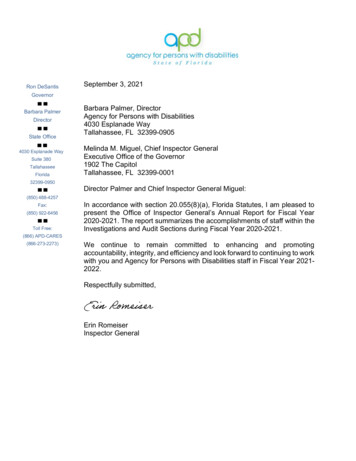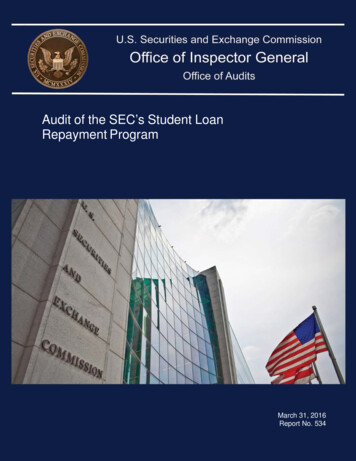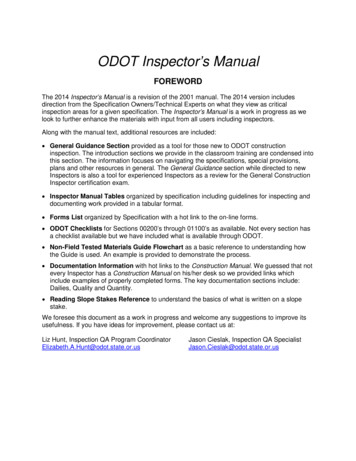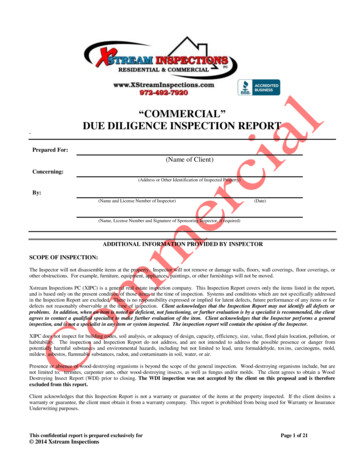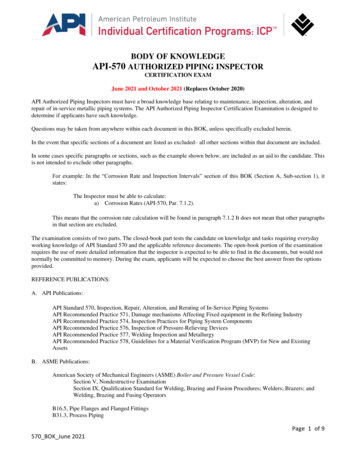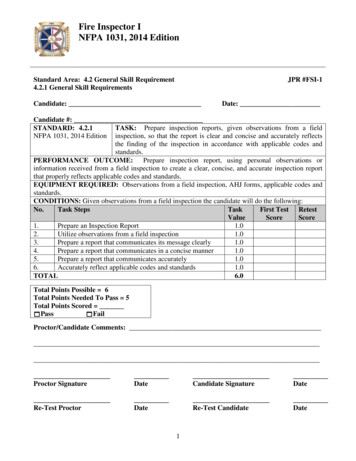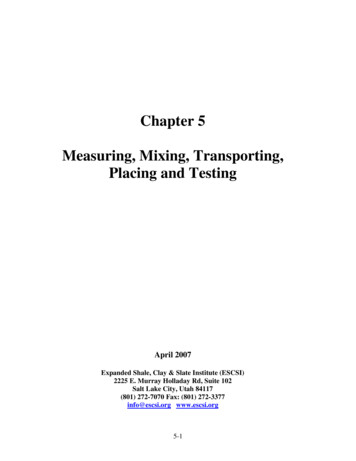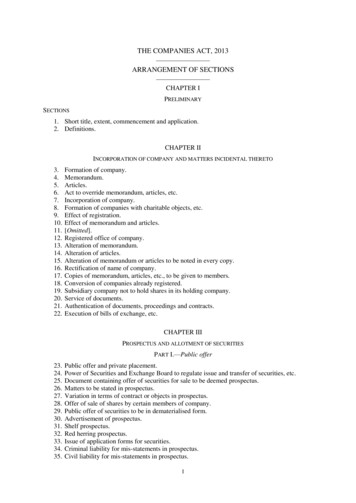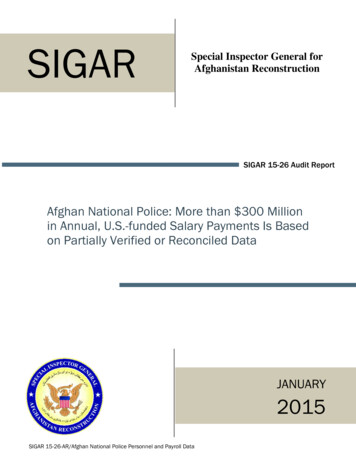
Transcription
SIGARN.Special Inspector General forAfghanistan ReconstructionSIGAR 15-26 Audit ReportAfghan National Police: More than 300 Millionin Annual, U.S.-funded Salary Payments Is Basedon Partially Verified or Reconciled DataJANUARY2015SIGAR 15-26-AR/Afghan National Police Personnel and Payroll Data
SIGARSpecial Inspector General forAfghanistan ReconstructionWHAT SIGAR REVIEWEDSince 2002, the U.S. government hasprovided more than 15 billion to train, equip,and sustain the Afghan National Police (ANP).In 2002, the United States and otherinternational donors established the Law andOrder Trust Fund for Afghanistan (LOTFA),administered by the United NationsDevelopment Programme (UNDP), to fundANP salaries and other payroll costs. As of July2014, the international community hadcontributed 3.6 billion to the fund, with theUnited States contributing 1.3 billion of thetotal.In March 2014, the Combined SecurityTransition Command-Afghanistan (CSTC-A)reported that the ANP had 152,678 assignedpersonnel, filling 97 percent of the force’s157,000 authorized positions. Although theAfghan Ministry of Interior (MOI) and the ANPcollect personnel and payroll data, CSTC-Aand UNDP are required to verify this data.Accurate data is necessary for the Afghangovernment to ensure the security andstability of the country—for example, byproviding police full and accurate salarypayments—and for the United States andothers to determine funding levels andtransition strategy as the Afghan NationalSecurity Forces assume control over securityin Afghanistan at the end of 2014.The objectives of this audit were to assess (1)the processes by which CSTC-A, UNDP, andthe Afghan government collect personnel andpayroll data for ANP personnel assigned andpresent-for-duty; (2) how CSTC-A, UNDP, andthe Afghan government store, access,transfer, and use this data; and (3) the extentto which CSTC-A, UNDP, and the Afghangovernment verify and reconcile ANPpersonnel and payroll data to determine theaccuracy of the data.January 2015Afghan National Police: More than 300 Million in Annual, U.S.-fundedSalary Payments Is Based on Partially Verified or Reconciled DataSIGAR 15-26-ARWHAT SIGAR FOUNDDespite 13 years and several billions of dollars in salary assistance to theAfghan government for the ANP, there is still no assurance that personnel andpayroll data are accurate. Since 2006, U.S. government audit agencies haveconsistently found problems with the tracking and reporting of Afghan NationalPolice (ANP) personnel and payroll data. Although all entities involved—the U.S.and Afghan governments as well as the international community—have beenworking to develop effective ANP personnel and payroll processes, thoseprocesses continue to exhibit extensive internal control deficiencies. In a 2011audit of the ANP payroll process, SIGAR found that many weaknesses—such asirreconcilable and unverified data, a lack of data reconciliation and verificationprocedures, and difficulties implementing electronic systems—continue to posechallenges to the Combined Security Transition Command-Afghanistan (CSTC-A),the United Nations Development Programme (UNDP) Law and Order Trust Fundfor Afghanistan (LOTFA), and the Afghan Ministries of Interior (MOI) and Finance(MOF).CSTC-A and UNDP rely on the MOI and the ANP to collect and accurately reportpersonnel and payroll data. However, the ANP’s process for collectingattendance data, which forms the basis of all ANP personnel and payroll data,has weak controls and limited oversight. ANP oversight officials are notgenerally co-located with the unit-level officer responsible for collectingattendance data. Further, neither CSTC-A nor UNDP officials are present tooversee the data collection and reported limited knowledge of and influenceover the process. Also, a daily sign-in, sign-out system for recording attendancewas reportedly only used by officers and not enlisted personnel, so there is nodocumentation that unit commanders are accurately reporting subordinatepersonnel attendance. All these factors could result in personnel being paid fordays not worked, either with or without knowledge of supervisory personnel.SIGAR found that the two main electronic systems used for ANP personnel andpayroll data—the Afghan Human Resource Information Management System(AHRIMS) and the Electronic Payroll System (EPS)—are not fully functional,cannot communicate directly with each other, and do not span all personneland payroll data processes. This situation exists, in part, because MOI-issuedANP identification cards and identification numbers—intended to be the bridgebetween the two systems—are not consistently or effectively used for dailyattendance, and some ANP personnel have not yet received an identificationcard. In addition, both systems contain thousands of personnel records withincorrect or missing identification numbers. As a result, controls—such asautomated data transfers, the capability to reconcile personnel betweensystems, and reduced dependence on handwritten reports—are not in place,and the risks of relying on untimely, inaccurate, or falsified ANP personnel andpayroll data persist.Even if AHRIMS and EPS were fully integrated, SIGAR found that the systemswould still have internal control weaknesses. AHRIMS (1) was unable toFor more information, contact SIGAR Public Affairs at (703) 545-5974 or sigar.pentagon.ccr.mbx.public-affairs@mail.mil.
WHAT SIGAR RECOMMENDSSIGAR recommends the Commander, U.S.Forces-Afghanistan—in coordination with theMOI, UNDP, and other donors—implementfive actions to improve oversight of the ANPpersonnel and payroll data collectionsprocesses; ensure that ANP incentivepayments and salaries are accurate; andimprove oversight of U.S. and other donorfunding for the ANP provided through LOTFA.These actions include using fully operationaland integrated electronic systems to trackand report all ANP personnel and payrolldata; implementing a process to verify thatANP personnel obtaining their salaries viatrusted agent receive full, accuratepayments; and ensure the LOTFA monitoringagent develops and documents a soundmethodology and consistently implements itwhen physically verifying personnel.In its comments, U.S. Forces-Afghanistanwelcomed all five recommendations anddescribed actions it is taking, and plans totake, to implement them. SIGAR will continueto monitor these actions to ensure that thecommand fully implements therecommendations.distinguish between active and inactive personnel, making it difficult for CSTC-Ato determine what percentage of active ANP personnel had records in thesystem; and (2) did not yet contain data matching active ANP personnel recordswith the authorized position each person was filling. Similarly, EPS (1) was notfully functional at all provincial headquarters, leaving records for over half ofANP personnel subject to manual data entry; (2) did not prevent payments tomore personnel per province than authorized; and (3) could not calculate orverify whether incentive payments or payroll deductions were accurate.SIGAR found that nearly 20 percent of ANP personnel are at risk of notreceiving their full salaries because they are paid in cash by an MOI-appointedtrusted agent, a process that lacks documentation and accountability. CSTC-Aand UNDP officials told SIGAR that there is limited oversight of trusted agentsand a higher risk that funds may be subject to corruption. Further, CSTC-Areported that corrupt practices within the trusted agent system of salarypayments “could take as much as 50 [percent] of a policeman’s salary.”CSTC-A, UNDP, and the MOI are each supposed to be responsible for verifyingANP personnel and payroll data. The verifications that these organizationsperformed were ad hoc and uncoordinated, and no one has conducted acomprehensive verification to cover all ANP personnel and payroll processes.CSTC-A could not provide us with written procedures for how it validates ANPpersonnel totals and officials confirmed that over the past year they accepted,without question, all personnel totals provided by the MOI. Because CSTC-Adoes not conduct required reconciliation practices, the command is unable toindependently verify that the correct number of ANP personnel is beingreported and that they are the same personnel who are receiving U.S. andother donor-funded salary payments. CSTC-A noted that limited staffingprevented the implementation of a full audit program as required by itsstandard operating procedures. Of concern, the only audit CSTC-A conducted in2013 of ANP payroll data identified serious deficiencies, including impropersalary deductions and late payments. CSTC-A officials also reported that theAfghan government has not provided required monthly financial and datareports and that CSTC-A has not requested the documentation due to staffshortages.UNDP has contracted with an independent monitoring agent to conduct regularverification of ANP payroll data and LOTFA expenditures. SIGAR found that theagent’s sampling methodology for physically verifying personnel was notsufficiently detailed and documented in its monitoring plan or reporting, andwas inconsistently applied. This inconsistent approach may have artificiallyinflated the percentage of successfully verified personnel from 59 percent to asmuch as 84 percent.SIGAR Personnel Verifying ANP IdentificationCards and AttendanceSource: SIGAR, April 19, 2014As U.S. and coalition forces continue to draw down and transfer securityresponsibility to the Afghan government by the end of 2014, the U.S.government will have increasingly limited visibility over ANP data collectionprocesses. As a result, the U.S. government will become even more reliant onthe MOI’s ability to verify the accuracy of the personnel and payroll data itcollects, as well as UNDP’s oversight of LOTFA funds. Unless the MOI developsthe capability to ensure and verify the accuracy of ANP personnel and payrolldata, there is a significant risk that a large portion of the more than 300million in annual U.S. government funding for ANP salaries will be wasted orabused.For more information, contact SIGAR Public Affairs at (703) 545-5974 or sigar.pentagon.ccr.mbx.public-affairs@mail.mil.
January 7, 2015The Honorable Chuck HagelSecretary of DefenseGeneral Lloyd J. Austin IIICommander, U.S. Central CommandGeneral John F. CampbellCommander, U.S. Forces–Afghanistan andCommander, Resolute SupportThis report discusses the results of SIGAR’s audit of the Combined Security TransitionCommand-Afghanistan’s (CSTC-A), the United Nations Development Programme’s (UNDP), andthe Afghan government’s processes for collecting and verifying the accuracy of Afghan NationalPolice (ANP) personnel and payroll data. The report includes five recommendations to theCommander, U.S. Forces-Afghanistan (USFOR-A)—in coordination with UNDP, other donors, andthe Afghan Ministries of Interior and Finance—to improve oversight of the ANP personnel andpayroll data collections processes; ensure that ANP incentive payments and salaries areaccurate; and improve oversight of U.S. and other donor funding for the ANP provided throughthe Law and Order Trust Fund for Afghanistan (LOTFA). These recommendations include usingfully operational and integrated electronic systems to track and report all ANP personnel andpayroll data; implementing a process to verify that ANP personnel obtaining their salaries viatrusted agents receive full, accurate payments; and ensuring the LOTFA monitoring agentdevelops and documents a sound methodology and consistently implements it when physicallyverifying personnel.We received written comments on a draft of this report from USFOR-A. USFOR-A welcomed allof our recommendations. The command’s comments are presented in appendix II.SIGAR conducted this work under the authority of Public Law No. 110‐181, as amended, andthe Inspector General Act of 1978, as amended; and in accordance with generally acceptedgovernment auditing standards.John F. SopkoSpecial Inspector Generalfor Afghanistan Reconstruction
TABLE OF CONTENTSBackground . 2ANP Attendance Data Collection Is Minimally Controlled and Lacks Direct Oversight . 6Inconsistently Used, Incomplete, and Unconnected ANP Data and Payment Systems Limit the Effectiveness ofControls . 7CSTC-A, UNDP, and MOI Lack Procedures for Ensuring the Accuracy of ANP Personnel and Payroll Data . 13Conclusion. 17Recommendations . 18Agency Comments . 19Appendix I - Scope and Methodology . 21Appendix II - Comments from U.S. Forces–Afghanistan . 24Appendix III - Acknowledgments . 33TABLESTable 1 - Data Systems Used to Store, Access, Transfer, and Use ANP Personnel and Payroll Data. 8FIGURESFigure 1 - ANP Personnel and Payroll Data: Key Players, Systems, and Data Flow . 5SIGAR 15-26-AR/Afghan National Police Personnel and Payroll DataPage i
ABBREVIATIONSAFMISAfghan Financial Management Information SystemAHRIMSAfghanistan Human Resource Information Management SystemANPAfghan National PoliceCSTC–ACombined Security Transition Command-AfghanistanEPSElectronic Payroll SystemGAOU.S. Government Accountability OfficeLOTFALaw and Order Trust Fund for AfghanistanMOFMinistry of FinanceMOIMinistry of InteriorUNDPUnited Nations Development ProgrammeUSFOR-AU.S. Forces-AfghanistanSIGAR 15-26-AR/Afghan National Police Personnel and Payroll DataPage ii
Since 2002, the U.S. government has provided more than 15 billion in funding to the Afghanistan SecurityForces Fund to train, equip, and sustain the Afghan National Police (ANP).1 In 2002, the United States, theAfghan government, and other international partners established the Law and Order Trust Fund for Afghanistan(LOTFA). LOTFA, administered by the United Nations Development Programme (UNDP), funds ANP salaries andother payroll costs. As of July 2014, the international community had contributed 3.6 billion to LOTFA, withthe United States contributing more than 1.3 billion, or about 38 percent, of the total.Current U.S. strategy calls for the ANP to reach a maximum strength of 157,000 personnel by January 2015,when the Afghan government will assume full responsibility for Afghanistan’s security. As of March 2014, theCombined Security Transition Command-Afghanistan (CSTC-A) reported that the ANP had 152,678 personnelassigned or had reached about 97 percent of its overall target.2 During Afghan fiscal year 1393—which beganon December 21, 2013, and ended on December 20, 2014—CSTC-A planned to provide the Ministry of Interior(MOI) with 515.1 million and an additional 308 million to LOTFA for ANP salaries and hazard andprofessional incentives.The Afghan government and ANP commanders need personnel data to effectively manage the police force,thereby safeguarding the security and stability of the country, as well as payroll data to help ensure policereceive full and correct salary payments. The United States and other stakeholders use the personnel andpayroll data to determine ANP funding levels and to guide transition strategy as the Afghan National SecurityForces assume greater control over security in Afghanistan, following the U.S. and coalition drawdown in late2014. Accurate and reliable accounting of ANP personnel will continue to be necessary to ensure fullaccountability over U.S. funds used to support the ANP, keep decision- and policy-makers accurately informedof the ANP’s personnel levels, and safeguard the future of the U.S. investment in Afghanistan after the 2014transition.As early as 2006, the Inspectors General for the Departments of State and Defense warned that CSTC-Areports on ANP personnel totals were unreliable, stating that the personnel numbers were “inflated and thereis no personnel accounting system in place.”3 Since then, we and other oversight agencies have identifiednumerous weaknesses and vulnerabilities in the ANP’s processes for tracking personnel and verifying salarypayments.4 These included weaknesses in fundamental ANP practices, such as a reliance on manual datacollection; limited U.S. and international oversight of data collection processes; difficulties implementingelectronic systems to manage and track the data; and little or no physical verification of ANP personnelassigned and present-for-duty.The objectives of this audit were to assess (1) the processes by which CSTC-A, UNDP, and the Afghangovernment collect personnel and payroll data for ANP personnel assigned and present-for-duty; (2) howCSTC-A, UNDP, and the Afghan government store, access, transfer, and use this data; and (3) the extent to1 The U.S. government also uses the Afghanistan Security Forces Fund to train, equip, and sustain the Afghan NationalArmy, which includes the Afghan Air Force. Together, the ANP and the Afghan National Army make up the Afghan NationalSecurity Forces.2On November 1, 2014, CSTC-A reorganized under the North Atlantic Treaty Organization’s Resolute Support organization.U.S. Department of State Inspector General and U.S. Department of Defense Inspector General, Interagency Assessmentof Police Training and Readiness, Department of State Report No. ISP-IQO-07-07/Department of Defense Report No. IE2007-001, November 2006.34 See also: U.S. Government Accountability Office, Afghanistan Security: Further Congressional Action May Be Needed toEnsure Completion of a Detailed Plan to Develop and Sustain Capable Afghan National Security Forces, GAO-08-661, June18, 2008; U.S. Government Accountability Office, Afghanistan Security: U.S. Programs to Further Reform Ministry of Interiorand National Police Challenged by Lack of Military Personnel and Afghan Cooperation, GAO-09-280, March 9, 2009; SIGARAudit-11-10, Despite Improvements in MOI’s Personnel Systems, Additional Actions Are Needed to Completely Verify ANPPayroll Costs and Workforce Strength, April 25, 2011; and Department of Defense Office of Inspector General, Governmentof the Islamic Republic of Afghanistan Needs to Provide Better Accountability and Transparency Over Direct Contributions,DODIG-2014-102, August 29, 2014.SIGAR 15-26-AR/Afghan National Police Personnel and Payroll DataPage 1
which CSTC-A, UNDP, and the Afghan government verify and reconcile ANP personnel and payroll data todetermine the accuracy of the data.5During this audit, we reviewed CSTC-A data collection and verification requirements, LOTFA projectdocumentation, and MOI and ANP standard operating procedures for data collection and oversight. We visitedthe provincial headquarters in Herat and Balkh provinces and an Afghan National Civil Order Police unit inHerat where we interviewed ANP officials, obtained ANP attendance documentation, and recorded personnelinformation for verification and reconciliation purposes. We obtained data from the ANP, the MOI, theElectronic Payroll System (EPS), and the Afghan Financial Management Information System (AFMIS). Weinterviewed CSTC-A, UNDP, MOI, and International Security Assistance Force officials familiar with ANPattendance procedures, relevant data systems, and the payroll process. We reviewed data verification plans,procedures, and reports, including CSTC-A audits, UNDP monitoring agent reports on LOTFA, and prior auditreports from the U.S. Government Accountability Office (GAO) and the Departments of State and DefenseInspectors General. We conducted our work in Kabul, Herat, and Balkh provinces in Afghanistan andWashington, D.C., from February 2013 through December 2014, in accordance with generally acceptedgovernment auditing standards. Appendix I contains a more detailed discussion of our scope and methodology.BACKGROUNDThe Afghan transitional government established the ANP—as called for by the 2001 Bonn Agreement—in 2002.The ANP is organized under the MOI and consists of the Afghan Uniformed Police, the Afghan Border Police,the Afghan Anti-Crime Police, and the Afghan National Civil Order Police.The Afghan government and the donor nations supporting the Afghan National Security Forces require thecollection of personnel and payroll data for all ANP personnel. Such data is necessary for the ANP to functionas a security force, maintain accountability, and accurately pay salaries. This data includes name, rank,identification number, and duty location, as well as daily attendance figures, base salary, and applicablefinancial incentives. CSTC-A, UNDP, and the Afghan government each have requirements for collecting,updating, and verifying ANP personnel and payroll data as follows: CSTC-A has been given primary responsibility within the Department of Defense for assisting theAfghan government with the creation of Afghan National Security Forces personnel accountabilitysystems. The National Defense Authorization Act for Fiscal Year 2008 requires the Secretary ofDefense to report, on any actions taken by the Department of Defense to assist the Afghangovernment in establishing ANSF personnel accountability system.6 CSTC-A is also responsible forfulfilling the requirement in the Act that the Department of Defense report on recruitment andretention numbers, rates of absenteeism, and other statistics for the ANP.7 CSTC-A has tasked its MOIMinisterial Advisory Group with collecting, validating, and analyzing the applicable ANP data, and theadvisory group is responsible for the accuracy of the information it reports.CSTC-A is also responsible for overseeing U.S. government direct assistance to the MOI, includingfunding provided for ANP salaries and other monetary benefits. According to CSTC-A’s directcontributions standard operating procedures, the MOI Ministerial Advisory Group is charged withensuring that the MOI establishes appropriate standard operating procedures and maintainsadequate fiscal controls and auditable records of all disbursements, including supportingdocumentation. In addition, this standard operating procedure requires CSTC-A’s FinancialManagement Oversight office to account for and oversee all direct assistance funding using measuresWe are concurrently conducting an audit of Afghan National Army personnel and payroll data, and expect to issue a finalreport in 2015.56National Defense Authorization Act for Fiscal Year 2008, Pub. L. No. 110-181, § 1231(c)(3), 122 Stat. 3, 391.7See id. § 1230.SIGAR 15-26-AR/Afghan National Police Personnel and Payroll DataPage 2
such as payroll and contract compliance audits, and is responsible for establishing and implementinga formal internal control program for direct assistance. CSTC-A’s commitment letter with the MOI andMinistry of Finance (MOF) for Afghan fiscal year 1393 further emphasizes the Financial ManagementOversight office’s role in providing oversight of direct assistance to the Afghan government.8 CSTC-A’sdirect contributions standard operating procedures further describes five reconciliations that shouldbe carried out during mandated audits. These requirements are to compare (1) authorized staffingdocuments against payment lists; (2) salary levels against payment lists; (3) incentive levels againstregulation and payment lists; (4) payment lists, payment summaries, and AFMIS data; and(5) payment lists, looking for duplicate bank account numbers. UNDP collects and verifies ANP personnel data based on requirements contained in LOTFA’s Phase VIProject Document.9 This document states that increasing accountability and transparency within theMOI, to ensure salaries are paid only to serving police personnel, requires continuous verification ofsalary disbursement at the central, provincial, and district levels. The document emphasizes theimportance of reconciling LOTFA disbursements with MOI records, reviewing food procurement anddistribution procedures, and supporting the MOI through capacity building.10 The Phase VI documentalso calls for improvements to ANP payroll accountability processes by using ANP personnelidentification tools in combination with electronic systems and funds transfers, and states that “MOIwill take the lead” in verification responsibilities. Complementing these requirements, CSTC-A’s fiscalyear 2014 bilateral agreement letter with UNDP states that LOTFA should only provide ANP salariesupon the successful implementation of an electronic human resources system. The letter also statesthat payroll funds should only be used to pay for verified personnel with a valid ANP-issuedidentification number.11 The Afghan government collects ANP attendance data on a daily basis. ANP Order 12/1391 requirescommanders to ensure correct personnel totals and to verify the existence of all personnel beforesigning attendance reports. In addition, CSTC-A’s commitment letter with the MOI and MOF for Afghanfiscal year 1393 states that the Afghan government must provide 13 financial and data reports toCSTC-A each month, including documentation of personnel totals, payroll lists, payment summaries,electronic funds transfer reports, and provincial headquarters-level records of payments to individuals.CSTC-A’s commitment letter also requires that an additional 14 documents, including attendancesheets, be made available to the command upon request. Finally, the commitment letter requires theMOI and MOF—the Afghan ministry charged with overseeing government expenditures—to useelectronic financial management and payroll systems to manage and track personnel and payroll data.ANP Personnel and Payroll Data Collection ProcessesAccording to CSTC-A, LOTFA, and Afghan government documents and interviews, verified through observationand interviews during site visits to ANP locations, ANP personnel and payroll data is intended to be collectedand transferred using the following processes. The MOI requires the ANP to record personnel attendance—present- and not present-for-duty—using daily check-in and check-out signatures. Each employee’s attendanceCombined Security Transition Command-Afghanistan, Bilateral Financial Commitment Letter between CSTC-A and theGovernment of the Islamic Republic of Afghanistan Ministry of Interior, October 22, 2013.89 LOTFA’s Project Document is the record detailing UNDP and other stakeholder roles and responsibilities for the currentphase of the trust fund ending January 1, 2015.10 Food procurement and distribution procedures include a cash stipend that patrol officers receive to purchase food foreach day they work.11 We addressed specific concerns about UNDP’s oversight of LOTFA with a series of inquiry letters (see SIGAR SpecialProject 14-57-SP, Inquiry Letter: UNDP LOTFA Oversight, May 13, 2014; SIGAR Special Project 14-98-SP, Inquiry Letter:UNDP LOTFA Oversight Response, September 12, 2014; SIGAR Special Project 14-99-SP, Inquiry Letter:CSTC-A Role of UNDP Oversight and Financial Management of LOTFA, September 17, 2014).SIGAR 15-26-AR/Afghan National Police Personnel and Payroll DataPage 3
information is manually passed to the provincial headquarters on a monthly basis. Once the data reaches theprovincial headquarters, ANP financial officials enter attendance data into EPS, the ANP’s payroll systemadministered by UNDP. Personnel updates, such as status or position changes, are entered into theAfghanistan Human Resource Information Management System (AHRIMS), a CSTC-A-developed humanresources system used for the ANP and Afghan National Army. Provincial officials use the data for twopurposes: (1) personnel totals, ranks, skills, and locations are used to facilitate planning and reporting forhuman resources needs; and (2) personnel salary levels, incentive and deduction amounts, and attendancedata are used to calculate salary payments.The provincial ANP headquarters also report personnel totals to the MOI, which aggregates them into amonthly report by province and provides the report to CSTC-A. CSTC-A uses these reports to develop, amongother products, its required submission for the Department of Defense’s biannual Report on Progress TowardSecurity and Stability in Afghanistan.Once ANP personnel and payroll data is collected, it is entered into a series of data systems using a number ofmanual entry and transfer processes. Data for new recruits, including each individual’s ANP identificationnumber, is collected during training at regional centers and added to recruits’ records in EPS and AHRIMS.12Provincial headquarters staff is responsible for updating individuals’ AHRIMS records to reflect changes instatus, including rank, duty location, and training, as well as updating individuals’ EPS records with monthlyattendance data. The MOI submits a payroll summary to the MOF, which administers AFMIS, the country’sgovernment-wide accounting system. Because AFMIS and EPS are not linked, MOF provincial-level staff entersdata from the MOI-provided payroll summaries into AFMIS and uses the data to determine final ANP personnelsalary payments.Once the MOF receives ANP salar
others to determine funding levels and transition strategy as the Afghan National Security Forces assume control over security in Afghanistan at the end of 2014. The objectives of this audit were to assess (1) the processes by which CSTC-A, UNDP, and the Afghan government collect personnel and payroll data for ANP personnel assigned and



